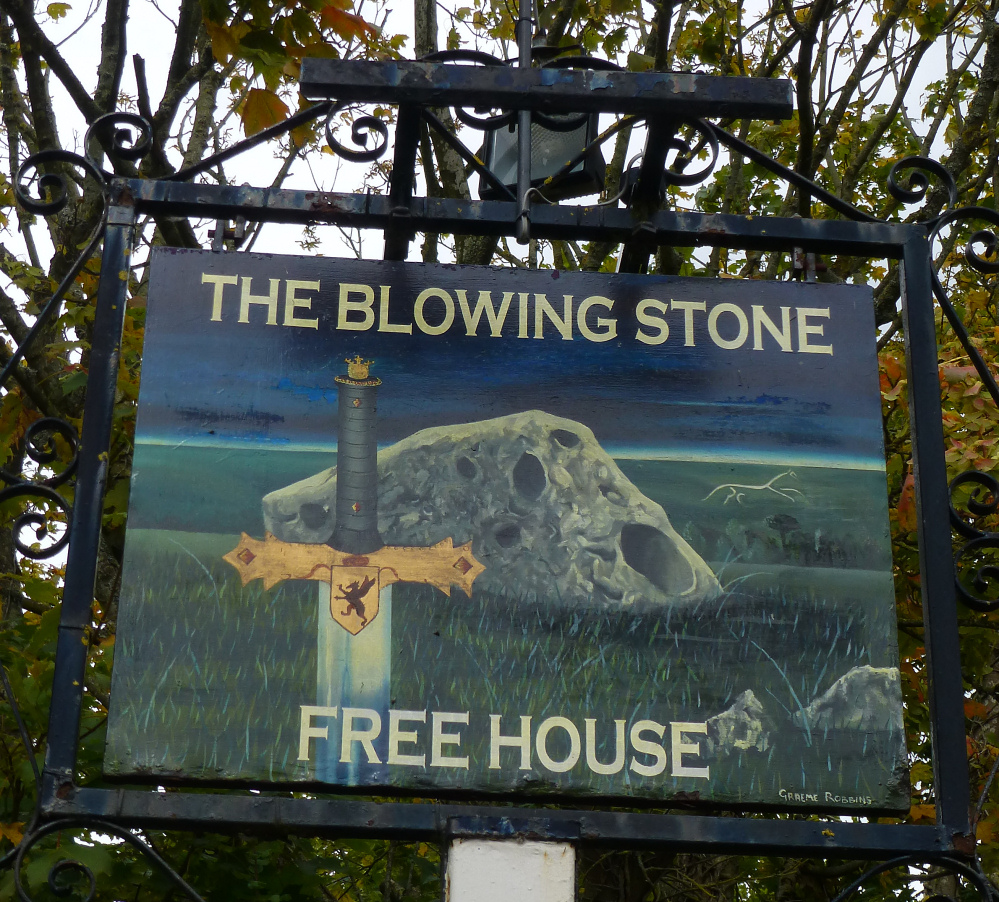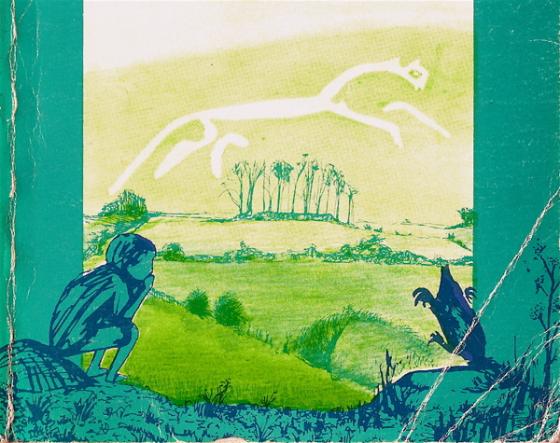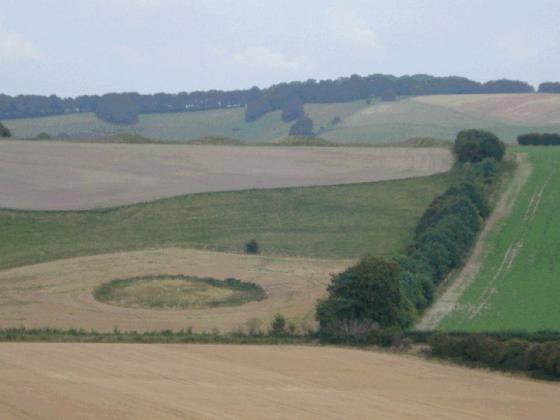
Blowing stone cottages,
Blowingstone Hill.

Blowing stone cottages,
Blowingstone Hill.





The pub has a new sign since Wysefool’s picture.

The bigger holes were full of water, leaving just this one. Pucker up now...

The stone in its domestic setting, with box of leaflets.

From volume 2 of Joel Cook’s (US) travelogue of England, 1900.
archive.org/stream/cu31924088013788#page/n199/mode/2up



Just put your lips together and blow......

The Blowing Stone – the sign on the tree reads:
Contributions to the blowing stone fund will be gratefully recieved by the local custodian. The proceeds are devoted to local charities.
(soz, can’t read the name underneath)

Pub sign from ‘the blowing stone’ at Kingston Lisle.

old postcard of blowing stone hill, the blowing stone itself being at the bottom of the hill. No date, But would guess late 19th century or early 20th. Of note is the un-metalled (surfaced) road. Locally, chalk was used for roads and tracks. This seems the most likely reason for some local roads being named ‘white road’.

This is the earliest photograph of the blowing stone that I have found. It was pasted inside the cover of an early copy of ‘The Scouring of the White Horse’ by Thomas Hughes (1892 edition), along with other photographs of local interest. One of the other photographs is dated 1902, so I suspect that this one is too.
Antiquarians; note the chain around it and running through the holes in the sarsen. Also, the cottages in the background are the ones that are still there. This is the location that the blowing stone is still in today.
Of major interest is the huge tree that the blowing stone is next too – That tree must have been felled many years ago.
I like the way the young kiddy is trying to find the right hole to blow into!




Look at the state of it!!!
Would *you* put your lips on that!
I don’t think so ...
This is a very British (i.e. a somewhat awkward, but rather endearingly so) trumpeting of the stone. The besuited Mr Chadwick is an accomplished musician in his other videos, so it must be nice for him to add Blowing Stone to his list of instruments.
I was struck by how similar the sound is to the carnyx – like those on the Gundestrup cauldron (you can hear some on this video ) – or is that just me overthinking things :)
Visited 13.11.11
Wow, what a great little site!
Easy to find and just about room to squeeze a car in on the verge near the stone itself.
Luckily when I opened the box there was one postcard and leaflet next. The postcard is 40p and the leaflet 20p – honesty box.
The leaflet is very informative and even gives instructions on how the ‘blow’ the stone! I didn’t try as I wasn’t sure which hole I should be blowing up!
I liked this stone a lot – glad I visited.
I’ve heard a lot about the Blowing Stone over the years, saw for the first time today. Wysefool and Rhiannon’s entries under folk-lore are well worth a read, I won’t duplicate them. For a small donation (towards the maintenance of the church in Kingston Lisle) you can pick up a leaflet by L.V. Grinsell (1993) which tells you everything you may need to know about the Blowing Stone. Most of it is included in previous fieldnotes and folklore entries.
Leaflet does say that stone is not officially classed as an ancient monument and is therefore not shown on OS maps in Old English lettering. Grinsell says the interest in the stone is botanical and geological rather than archaeological.
Leaflet is in itself a little gem – worth stopping by to see stone and pick up a leaflet.
I caught sight of this in the corner of my eye as I hurtled past down the hill. After a rapid bit of uphill reversing to the space opposite the top cottage, I trotted cheerfully across. It’s so nice that such curious things have managed to survive, and its neighbours are clearly proud of it, judging by the boldness of their house signs for ‘blowing stone cottages’.
I ought to admit that the first thing that popped into my head was that cheesy film from my childhood, Flash Gordon. You know, that stupid bit where the bloke off Blue Peter plunged his arm into the tree stump full of holes and got fatally mauled. Surely you remember. My point is that there are just so many holes in the Blowing Stone. How would you know which one to try blowing into? You could be there all day without instruction. Quite a few of them contained snails. I balked and chickened out. Partly because of the snails and partly because I could hear the occupants of the nearest cottage in their garden. I thought I’d save them from having to listen to me spitting and coughing.
There’s a little box containing postcards and leaflets – the leaflet by good old Mr Grinsell.
There’s a round flat stone right in front of the Stone – I’m intrigued to see it’s probably the same one raised up in Wysefool’s vintage photo?
...a peculiar beast indeed, lurking in its own picket-fenced enclosure in front of a line of small chalk-built cottages. It seems so lost and lonely, ‘what great site had this been part of?’, I wondered. It felt like the last of its line, a curiosity like a stuffed animal in a museum. But having said that, I liked it hugely and enjoyed it’s quirky resting place nestling at a crossroads in deepest Oxfordshire.
A must-stop on any visit to the Uffington White Horse or Lambourn Seven Barrows. Head east from the White Horse towards Wantage. Look for the crossroads at Kingston Lisle, with the sign pointing North to the “Blowing-Stone” inn – turn South (towards Lambourn), and the Blowing Stone is on your left, at the start of the row of houses at the bottom of the hill. Parking is dodgy, but there’s gate further up on the right where you might squeeze in.
The stone was moved here sometime in the 18thC, when it was the centrepiece of the old Blowing-Stone inn ... the story is that if positioned correctly, you can get a note out of this (like so much around here, there is a local-boy King Alfred story attached). However, you would need to be both insane (to put your lips anywhere near the thing) and have the lung-capacity of an elephant to get even a peep out of it.
If you do, then the whole valley will resound to it’s magnificent timbre
Good luck
‘Famous among local relics is the Blowing Stone, moved from the Ridgeway to Kingstone Lisle and to be seen at a farm below Blowing Stone Hill. A mournful wail is achieved by blowing into a hole in this stone. Some say this was the stone used by King Alfred for summoning his troops, others that it is of Druidical origin, and a third opinion places it among many large stones found locally and believed to be survivals of the ice age.‘
The Berkshire Book
by the Berkshire Federation of Women’s Institutes
This stone, which utter’d many a blast,
In silence lay for ages past,
By man unheard, by man unseen.
Tradition said it once had been,
And that for miles its loud alarms
Were heard, when Alfred blew to arms;
And this tradition had it still
The stone was on the White Horse Hill.
From sire to son the Blow Stone tale
Thus circles round the White Horse Vale.
In recent times this stone was found,
Imbedded near the battle ground.
The wandering shepherds first saw there
And Atkins has preserved with care
This mystic remnant of the day
When Alfred ruled with regal sway;
And when the wise decrees of fate
Made friend and foe confess him great,
This trumpet loudly did proclaim
His wars, his wisdom, and his fame.
- from a poem entitled A Day on the Downs, 1855
The blowing stone legend is related to King Alfred, like many places in the local area. The victorians were very fond of King Alfred and romanticised him heavily. The statue of him in the marketplace at Wantage is a lasting testiment to their love of the ‘first english king’.
The legend concerns the battles of King Alfred against the mighty Dane. It is said that he called his armies to battle by using the blowing stone as a huge horn which echoed around the vale (of the white horse).
I have found many references to the blowing stone being moved from somewhere on the ridgeway to its present position. This seems very likely. The legend is surely just a legend created much later in the life of the blowing stone.
Could it be more like a continuation of a pre-christian (i.e. heathen) tradition of ‘kissing the stone’ – pagan stone worship in the 21st Century? in the middle of rural Oxfordshire?
maybe, maybe not but you kiss the blarney stone in Ireland as well...
Summary of Proceedings of the Bath Natural History and Antiquarian Field Club for the years 1865-6.
[...] The first [Excursion] of the season, to Wantage, the Berkshire White Horse, and Uffington, was a success in every way, due chiefly to the admirable arrangements made by Mr. Wasbrough for the transit and conveyance of the members. Under this gentleman’s guidance the chief points of interest in the birth place of King Alfred were visited [...]. Leaving Wantage the members proceeded in carriages to the foot of the Downs, and essayed a blast upon the blowing stone (a mass of perforated silicious sandstone, said to have been formerly used for sounding an alarm over the neighbouring country).The united efforts of all Bath were unable to produce a sound from the trumpet shaped hole. A native trumpeter, however, being found was more successful, and satisfied all present that when in its original place on the top of the Downs a most effective alarm could be raised.
Just watched a DVD called Along The Ridgeway and one of the presenters gets a loud noise out of the Blowing stone.
He blows through the very small hole on the top of the stone, after a child shouts instructions from the window of one of the cottages.
What do you think happens when you leave a blowing stone outside a pub? Yep, every drunk staggering home at 1 in the morning thinks they’ll have a go. So there’s only one thing to do – lock it up.
The aperture to the mouth-piece is closed with a wooden trap upon rude hinges. This is fastened with a padlock and chain [..] The landlord of the inn made great difficulty about permitting us to have a blow upon the Sabbath-day, ‘because’ said he, ‘it do so tease the Squire at Kingston Hall’ (which is three-quarters of a mile from the stone). However, he perceived we were odd folk*, and that we had a sketch of the Berkshire wonder, upon the exchange of our silver key for his iron one, we had liberty to unfasten the lid.
Needless to say, at the terrible racket everyone came out of the ale house, and so the perpetrators retreated, everyone “looking after our trail wrathfully and gloomily, as if we had committed a sacrilege.”
from p271 of ‘The Wanderings of a Pen and Pencil’ by FP Palmer and Alfred Forrester (1846) – at Google Books.
*perhaps a familiar response to modern visitors of tma-type spots the country over.
You can see the security arrangements in Wysefool’s photo here
themodernantiquarian.com/post/21097/images/blowing_stone.html
‘Yet the stone was certainly in its present position in 1761. In 1749 the Atkins family bought the Kingston Lisle estate which they retained until sometime after 1907, and in view of statements in the following poem published in 1855 (NOTE: this is entitled ‘A day on the downs’ and is described in another post for this site), I am inclined to think that the stone was found on or near White Horse Hill between 1750 and 1760 and its blowing properties recognised, as a result of which it was moved to its present position in front of the cottages at the instigation of a member of the Atkins family’.
L V Grinsell – White Horse Hill and surrounding country
‘The tradition that King Alfred blew through it to summon the Saxons to fight the Danes is probably more picturesque than historically true. It has in fact been sometimes known as King Alfred’s Bugle Horn. I beleive the Alfred tradition connected with this stone is traceable to the influence of Wise’s Letter to Dr Mead (1738) and the theory which he expounded in that work’.
L V Grinsell – White Horse Hill and Surrounding Country
From Chapter 1 of Tom Brown’s Schooldays, by Thomas Hughes (1857).
“What is the name of your hill, landlord?”
“Blawing STWUN Hill, sir, to be sure.”
[READER. “Stuym?”
AUTHOR: “Stone, stupid--the Blowing Stone.“]“And of your house? I can’t make out the sign.”
“Blawing Stwun, sir,” says the landlord, pouring out his old ale from a Toby Philpot jug, with a melodious crash, into the long-necked glass.
“What queer names!” say we, sighing at the end of our draught, and holding out the glass to be replenished.
“Bean’t queer at all, as I can see, sir,” says mine host, handing back our glass, “seeing as this here is the Blawing Stwun, his self,” putting his hand on a square lump of stone, some three feet and a half high, perforated with two or three queer holes, like petrified antediluvian rat-holes, which lies there close under the oak, under our very nose. We are more than ever puzzled, and drink our second glass of ale, wondering what will come next.
“Like to hear un, sir?” says mine host, setting down Toby Philpot on the tray, and resting both hands on the “Stwun.” We are ready for anything; and he, without waiting for a reply, applies his mouth to one of the ratholes.
Something must come of it, if he doesn’t burst.Good heavens! I hope he has no apoplectic tendencies. Yes, here it comes, sure enough, a gruesome sound between a moan and a roar, and spreads itself away over the valley, and up the hillside, and into the woods at the back of the house, a ghost-like, awful voice.
“Um do say, sir,” says mine host, rising purple-faced, while the moan is still coming out of the Stwun, “as they used in old times to warn the country-side by blawing the Stwun when the enemy was a-comin’, and as how folks could make un heered then for seven mile round; leastways, so I’ve heered Lawyer Smith say, and he knows a smart sight about them old times.”
We can hardly swallow Lawyer Smith’s seven miles; but could the blowing of the stone have been a summons, a sort of sending the
fiery cross round the neighbourhood in the old times? What old times? Who knows? We pay for our beer, and are thankful.
Online at Project Gutenberg
gutenberg.org/dirs/etext98/tbssd10.txt
At the site, there is usually a leaflet about the legend of the blowing stone that you can take (for a small contribution). It explains the folklore and written references. Worth a quick stop if you are heading to White Horse Hill or Waylands Smithy.





























































